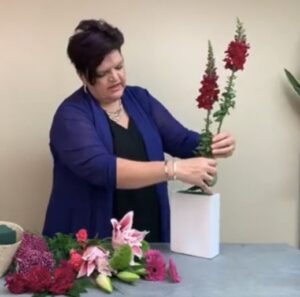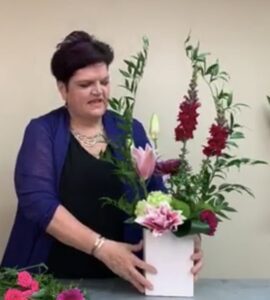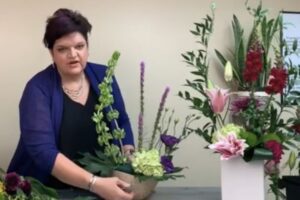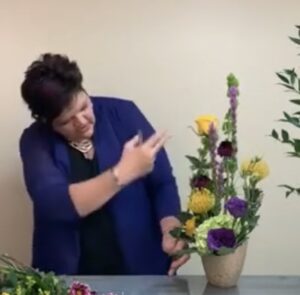By Sandy Schroeck AIFD, PFCI, CFD

What is one of the things you can do to increase customer satisfaction with your designs? Today we are going to talk about the depth of your stem insertions in your foamed compositions. It’s one of my most significant challenges in teaching floral design.
The long-lasting qualities of your arrangements can be the best form of advertising for your shop! Our fabulous designs in the customer’s minds last as long as the last flower that dies. How many times have you had someone tell you that arrangement lasted three weeks? As you think about it, we know the iris didn’t last that long, but the alstroemeria and carnations extended the life of that design, increasing customer satisfaction. It’s not enough for us to make cool designs as floral professionals. We must also think about the lasting qualities; all the way from the variety of flower choices to the mechanics you use to create your designs
 .
.
Today we are using Oasis Maxlife foam with enhanced biodegradability. This foam was created to match the cell structure of the flower capillary system. In lab testing, Maxlife foam will keep flowers fresher much longer than other foams. The foam holds 40 times its weight in water and will release it to keep the flower hydrated. But we all know that gravity does also affect water. If a customer doesn’t add water to an arrangement, where is the concentration of water going to be? It will dry out from the top down and outside to the inside. Thus where would the target of your stem insertion be? I try to aim for a deep insertion of that stem targeting about 1 inch above the base of the foam block. When I first started working with foam oh too many years ago, I started with the block that rose an inch or two above the container. In some cases, I still follow that process if I plan to have some extended insertions on the horizontal plane or large event centerpieces. But most of my daily work, the foam is level with or a little above the rim of the container.
I like to design in foam because it gives me control of stem placement. It is essential to emphasize the line and the negative space that can be created with my flower and foliage placement—thinking about the flower having enough space to mature. Selling negative space is very profitable; design can be very impactful with some added creative flair. I also have confidence in the solid mechanics that the design will arrive at my customer in the same fashion it was created in.
For less experienced designers, it is easier to determine the stem length and where to properly cut by pulling the container to the edge of the table and holding the stem so you can see target length, pinch your fingers at the position to cut, and make the cut. This allows you to be confident and efficient with your insertions, hitting the target zone for maximum water availability. If you don’t like the placement, take it out and insert it into a different foam position. Re-cut the base of the stem a little and reposition.
 Everyone knows I teach many design classes, and this issue became very apparent when we analyzed the designs. I might try to move one of the flowers, and I realize many designers are cutting the flowers quite short, and we don’t have enough stem left to be able to move the flower. This is my biggest frustration, and the most important point I can teach a new designer. Some old ones too that have been doing this for years. Trust me; I have been surprised to see this with experienced designers as well as new ones. Now I make if a point to talk about that at the beginning of classes and it still happens. I know the flower started with a beautiful long stem that is now laying on the floor and decreasing the ability for that flower to continue to drink.
Everyone knows I teach many design classes, and this issue became very apparent when we analyzed the designs. I might try to move one of the flowers, and I realize many designers are cutting the flowers quite short, and we don’t have enough stem left to be able to move the flower. This is my biggest frustration, and the most important point I can teach a new designer. Some old ones too that have been doing this for years. Trust me; I have been surprised to see this with experienced designers as well as new ones. Now I make if a point to talk about that at the beginning of classes and it still happens. I know the flower started with a beautiful long stem that is now laying on the floor and decreasing the ability for that flower to continue to drink.
 I cannot stress enough how important the depth of your insertions can affect your design’s longevity. The success of your future in this business is dependent on it. Use foam successfully and add that creative flair into your arrangements to make them stand out from the competition.
I cannot stress enough how important the depth of your insertions can affect your design’s longevity. The success of your future in this business is dependent on it. Use foam successfully and add that creative flair into your arrangements to make them stand out from the competition.
** Hydrangea in foam – Best practices, start with clean buckets, add preservative water, hydrate at room temp for a couple of hours, then store in the cooler. When you are ready to design, take off leaves to reduce transpiration and place stem deep into the foam into the target zone.
